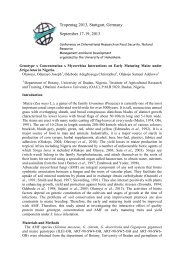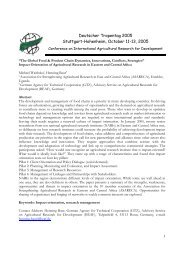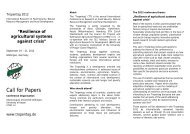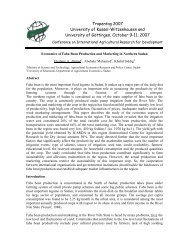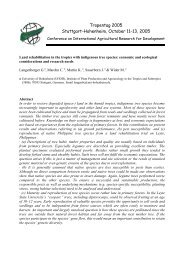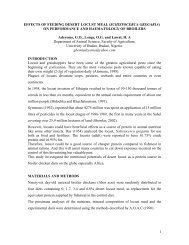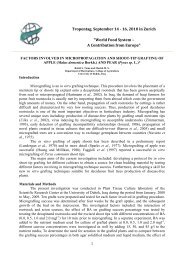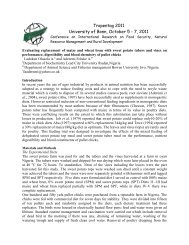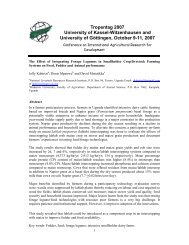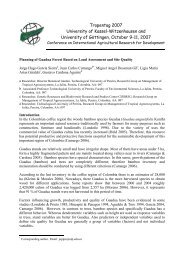Innovative Development of a Cassava Processing Machine
Innovative Development of a Cassava Processing Machine
Innovative Development of a Cassava Processing Machine
You also want an ePaper? Increase the reach of your titles
YUMPU automatically turns print PDFs into web optimized ePapers that Google loves.
Tropentag 2012, Göttingen, Germany<br />
September 19-21, 2012<br />
Conference on International Research on Food Security, Natural Resource<br />
Management and Rural <strong>Development</strong> organised by:<br />
Georg-August Universität Göttingen and University <strong>of</strong> Kassel-Witzenhausen<br />
<strong>Innovative</strong> <strong>Development</strong> <strong>of</strong> <strong>Cassava</strong> <strong>Processing</strong> <strong>Machine</strong> as Solution to Crisis against<br />
Agricultural Systems<br />
Kolawole a , Oladele Peter, Leo Agbetoye a , A. S. Ogunlowo a Lateef Sanni b , and Abass Adebayo b<br />
a Agricultural Engineering Department, The Federal University <strong>of</strong> Technology, Akure Nigeria.<br />
b International Institute <strong>of</strong> Tropical Agriculture (IITA), Ibadan Nigeria.<br />
Introduction<br />
Maize and cassava (Manihot esculenta Crantz) are the most important sources <strong>of</strong> calories in sub-<br />
Saharan Africa (Haggblade et al., 2012). A degree (1°C) increase in temperature can reduce<br />
maize production by 17% (Oseni and Masarirambi, 2011). The rising world average temperature<br />
and unpredictable rainfall are threatening global food grain supply (Kolawole, 2012). For many<br />
African countries, investment in irrigation for production <strong>of</strong> staple food grains is financially<br />
difficult. <strong>Cassava</strong> gives reasonable yield under marginal soil conditions and it is tolerant <strong>of</strong><br />
drought (Kolawole et al., 2010). For this reason, it is rapidly overtaking maize and other food<br />
grains as an important staple food in many parts <strong>of</strong> Africa, stabilizing the food security status <strong>of</strong><br />
the poor. However, cassava roots cannot be stored for too long. <strong>Cassava</strong> is best stored in the form<br />
<strong>of</strong> flour. High quality cassava flour (HQCF) can conveniently replace maize or wheat flour<br />
(Abass et al., 2011). Many food products (Figure 1) can be made from HQCF. The inclusion <strong>of</strong><br />
HQCF in wheat flour can significantly reduce the huge food import bills in Africa (Adesina,<br />
2012).<br />
Figure 1. Food product from cassava Figure 2. Peeling <strong>of</strong> cassava tuber by women<br />
Producing HQCF from cassava roots at the village level involves peeling, washing, grating,<br />
dewatering, pulverizing, sieving/sifting, and drying. Tools for processing HQCF require<br />
innovation. Peeling cassava roots immediately after harvesting is a difficult operation, mostly<br />
done by women (Figure 2). Hand peeling is currently the only feasible option (Sanni, 2004).<br />
Grating cassava roots to mash can effectively be done with powered graters. Dewatering the<br />
mash is another tedious operation. The traditional method involves packing the mash inside<br />
1
polypropylene sacks and pressing with heavy stones for 24 ‒ 48 hours. Improved dewatering is<br />
done with a mechanical press to apply pressure on polypropylene sacks that contain the grated<br />
cassava mash within 2-4 hours. Constraints to cassava processing include the absence <strong>of</strong><br />
appropriate processing machines at the village level. The traditional operation allows skin contact<br />
with the cassava mash. All cassava tissues contain toxic cyanogenic glycosides (McMahon et al.,<br />
1995). Mash process stages expose workers to ailments and disorders <strong>of</strong> ergonomic origin<br />
(Fajemilehin and Jinadu, 1992). The use <strong>of</strong> raffia sieve (Figure 3) for pulverizing and sifting<br />
cassava cake during flour processing is unhygienic and hazardous (Sanni et al., 2008). <strong>Innovative</strong><br />
development <strong>of</strong> cassava processing machines can help stimulate agricultural growth. Attempt was<br />
made to combine the efforts made so far.<br />
Figure 3. Conveying, dewatering and sifting<br />
Material and Methods<br />
The parameters affecting dewatering <strong>of</strong> cassava mash during processing were evaluated using<br />
fabricated experimental equipment and existing models. IITA TMS 4(2) 1425 variety at three<br />
levels <strong>of</strong> maturity, i.e., 9, 12, and 15 months after planting, was used in the study. Parameters<br />
studied were pressure drop, face area <strong>of</strong> the filter medium, and mash resistance. The mash<br />
resistance varied with the age <strong>of</strong> the cassava: the highest value was 5.4 × 10 11 m/kg. Medium<br />
resistance also varied with the age, 3.3 × 10 11 /m. The volume <strong>of</strong> filtrate, 3.71 × 10 -3 m 3 , was<br />
obtained from the 12-month-old sample with 9.45 × 10 -2 kg mash cake deposit on the filtering<br />
medium. The Kozemy constant (Ko) value for TMS 4(2) 1425 variety was found to be 1.14 × 10 7<br />
and porosity <strong>of</strong> mask cake was 0.0181 at 50% moisture content wet basis. These parameters were<br />
used in the modification <strong>of</strong> existing flow chart (Figure 4), and the mash processes <strong>of</strong> conveying,<br />
dewatering, pulverizing, and sieving were combined into one machine.<br />
Figure 4. Process flow chart Figure 5. <strong>Cassava</strong> mash process machine concept<br />
2
This was translated into workable machine components for further development (Figure 5).<br />
Figure 6. The machine Prototype<br />
Results and Discussion<br />
The newly introduced mash process machine combined conveying, dewatering, pulverizing and<br />
siefting (Figure 6). The result obtained show that slow screw speed yielded a smaller volume <strong>of</strong><br />
liquid (Figure 7). Decreased throughput was observed with increase in screw speed (Figure 8).<br />
Conversely high screw speeds produced wetter solids and short resident times (Figure 9). The<br />
recovery <strong>of</strong> solids from liquid improves with the introduction <strong>of</strong> a 300 N spring force as back up.<br />
There was an increase in temperature <strong>of</strong> sample at higher speed (Figure 10) also at higher spring<br />
force. The results show that the higher the feed screw speeds, the lower the machine efficiency.<br />
Higher temperature could lead to gelatinization <strong>of</strong> the mash. Heated mash is unsuitable for<br />
HQCF. The best result was obtained at moderate screw speeds <strong>of</strong> between 40‒50 rpm at a spring<br />
force <strong>of</strong> 200 N. The product moisture content was reduced from 68% to about 47% moisture<br />
content wet basis. This innovation includes pulverizing <strong>of</strong> the cake as part <strong>of</strong> the process.<br />
4.5<br />
4<br />
3.5<br />
3<br />
2.5<br />
2<br />
1.5<br />
1<br />
0.5<br />
0<br />
O u t p u t , k g<br />
TMS4(2)1452<br />
20 40 60 80 100<br />
Screw speed, rpm<br />
100N<br />
200N<br />
300N<br />
R e s i d e n t t i m e , m i n .<br />
12<br />
10<br />
8<br />
6<br />
4<br />
2<br />
0<br />
TMS(2)1425<br />
20RPM 40RPM 60RPM 80RPM 100RPM<br />
Screw speed,rpm<br />
100N<br />
200N<br />
300N<br />
T e m p e r a t u r e C<br />
3<br />
60<br />
50<br />
40<br />
30<br />
20<br />
10<br />
0<br />
TMS 95-0058<br />
20 40 60 80 100<br />
Screw speed, rpm<br />
100N<br />
200N<br />
300N<br />
v o l u m e o f e x p r e s s e d<br />
j u i c e , l i t r e s<br />
1.2<br />
1<br />
0.8<br />
0.6<br />
0.4<br />
0.2<br />
0<br />
TMS95/0058<br />
20 40 60 80 100<br />
Screw speed, rpm<br />
Figure7. Output/ circle Figure 8. Expelled juice Figure 9. speed and temp. F10 speed / resident time<br />
100N<br />
200N<br />
300N
Conclusions and Outlook<br />
Food security is the right <strong>of</strong> all people to healthy and culturally appropriate foods. Bakery flour<br />
requirement can now be met with HQCF without depending entirely on imported grains. Africans<br />
need good cassava processing machines. <strong>Innovative</strong> mechanization will allow processors to<br />
produce the flour without drudgery. <strong>Innovative</strong> development <strong>of</strong> other cassava processing<br />
machines will be needed. Commercial development <strong>of</strong> this machine will improve food security in<br />
the face <strong>of</strong> climate change-induced agricultural calamities.<br />
Acknowledgements<br />
This work was supported by (STEP-B) Innovators <strong>of</strong> Tomorrow (IOT) research grant,<br />
Federal Ministry <strong>of</strong> science and Technology, Abuja Nigeria.<br />
References<br />
Abass, A. B.; Bokanga, M.; Dixon A. and Bramel P. (2011) Transiting <strong>Cassava</strong> into an Urban<br />
Food and Industrial Commodity through Agro-processing and Market Driven Approaches:<br />
Lessons from Africa. In: da Silva, C.A., and Mhlanga, N. (Eds.), <strong>Innovative</strong> Policies and<br />
Institutions in Support <strong>of</strong> Agro-Industries <strong>Development</strong>. Food and Agriculture Organization <strong>of</strong> the<br />
United Nations, pp. 305–352<br />
Fajemilehin, B. R. and Jinadu M. K. (1992). Occupational Health Hazards Associated with<br />
Traditional Methods <strong>of</strong> <strong>Cassava</strong> <strong>Processing</strong> in Nigeria Finnish Institute <strong>of</strong> Occupational Health<br />
African Newsletter 2/1995 Health, supplement, p.38–39.<br />
Haggblade, S.; Djurfeldt, A. A.; Nyirenda, D. B.; Lodin, J. B.; Brimer, L.; Chiona,M.: Chitundu,<br />
M.; Chiwona-Karltun,L.;Cuambe,C.;Jirström,M.; Dolislager, M.; Donovan,C.; Droppelmann,K.;<br />
Kambewa, E.; Kambewa, P.; Meso, N.; Mahungu, N.M. ; Mkumbira, J.; Mudema, J.;<br />
Nielson,H.; Nyembe,M.;Salegua,V.A.;Tomo,A.; Weber,M.; (2012). <strong>Cassava</strong> commercialization<br />
in Southeastern Africa , Journal <strong>of</strong> Agribusiness in Developing and Emerging Economies Vol. 2<br />
Iss: 1pp. 4–40<br />
Adesina A.(2012) Nigeria’s Agriculture Minister speech at 45th year anniversary <strong>of</strong> IITA<br />
www.iita.org<br />
Sanni L. O., (2004). Fabricators <strong>of</strong> <strong>Cassava</strong> <strong>Processing</strong> Equipment Workshop: National Centre<br />
for Agricultural Mechanization Ilorin. Business Vanguards. Friday, 24th December<br />
Sanni, L. A.; Ogunsina, B.S.; Oladigbo, C.(2008) <strong>Development</strong> <strong>of</strong> a Rotary Pulverizer for<br />
<strong>Cassava</strong> Cake in Gari Production Journal <strong>of</strong> Food Process Engineering Vol. 31:6, 783–797.<br />
Kolawole, O. P. (2012) Global Warming and Food Engineering World Environment Scientific<br />
and AcademicPublishing Vol 2 No 4<br />
Oseni T. O. and Masarirambi M T (2011) Effect <strong>of</strong> Climate Change on Maize (Zea mays)<br />
Production and Food Security in Swaziland. American-Eurasian J. Agriculture and Environment<br />
Science. Vol.11 :3, 385-391<br />
4



